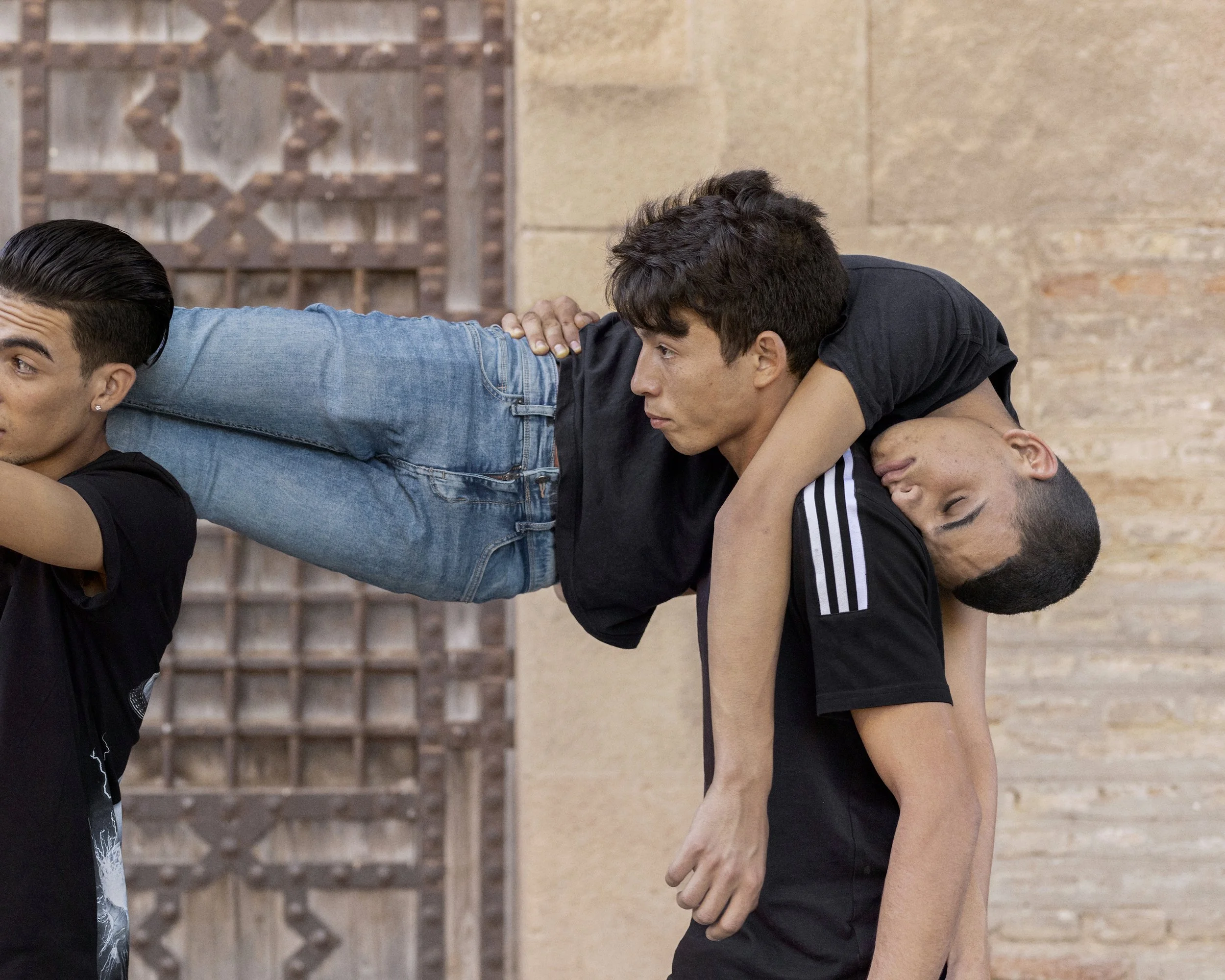Installation view from Felipe Romero Beltrán’s solo presentation, ‘Dialect’, Paris Photo with HATCH, 2023, Paris. Photo: Jitske Nap. Courtesy of the artists and Hatch Gallery.
Paris Photo
Felipe Romero Beltrán
Section Curiosa - Booth SC16
Curated by Chiara Agradi
November 9 - 12, 2023
Grand Palais Éphémère - Pl. Joffre, 75007 Paris
Press:
Performing the Body to Give Shape to Waiting
During a period spent with a group of young migrants from North Africa who had sought refuge in Seville, Felipe Romero Beltrán created Dialect (2020-2023). This photographic series focuses on a very unique stage of their tumultuous and painful migratory experience: the spatiotemporal pause in which these migrants live in a reception center, awaiting the Spanish state's decision regarding their legal status. While the nature of the subject inspires a photojournalistic approach, the way the images are staged suggests that a reading through the prism of documentary photography does not entirely sum up the artist's intentions.
By straddling the line between social criticism and storytelling, Romero Beltrán delves into the realm of waiting, building a relationship of trust with his subjects. The images he captures result from shared experiences and exchanges rather than mere observation. This particular sensitivity to the phenomena of uprooting and rooting inherent in migratory experiences seems to stem from the artist's personal journey. As a Colombian artist initially trained in photojournalism in Buenos Aires and later an immigrant in Europe, he faced administrative hostility and the challenge of integration into a new legislative, social, and cultural context.
Romero Beltrán chooses to use photography to highlight the bureaucratic downtime and to inquire about the physical and psychological condition of these young individuals. He immortalizes their bodies at a standstill, facing uncertainty, deprived of their identity, and waiting to obtain a new one. To achieve this, he plays with the codes of documentary and fiction in favor of images where events, personal narratives, and even his own past fantasies intertwine in a dense narrative.
In this context, we can place the work Recital (2020), part of the Dialect project, which consists of a three-part film showing migrants grappling with the reading of the initial pages of the Spanish immigration law. Once again, documentary rigor and fiction converge in a work that questions a transitional state, manifested in the contrast between the effort to learn a new language and the mechanical, naive sound of someone expressing themselves in an unfamiliar idiom.
His approach aligns with the thinking of Susan Sontag, who, in her essay "Devant la douleur des autres", asserts that a photographic image is the result of choice and that taking a photograph means framing and excluding certain elements from the composition. In her work, she considers the interaction between the media and our perception of war disasters, challenging the idea that photography, particularly images of suffering, confronts us with "truth."
Building upon this challenge to the notion of truth and the singularity of the frozen moment, Felipe Romero Beltrán combines the poetics of documentary and performance. He asks young migrants to interpret, through theatrical poses, pivotal moments from their migratory experiences. These images result from a staged production orchestrated by the photographer, but with a scenario co-authored by the participants: the revisiting of a painful past and the way it is brought back to life become endurable through collective effort.
Yet, these images exude gentleness; If one of the distinctive features of contemporary life is the proliferation, through the media, of countless portrayals of the horrors occurring worldwide, there is no room for violence in Romero Beltrán's series. He deserves credit for treating his subjects with great humanity.
In Dialect, the body is examined in its relationship with official authority. “Crossing the border involves a physical effort that questions the body in all its forms and metaphors," writes Juan Bockamp in his text Stepanov Notation for the piece Instruction. The robust anatomy of these young individuals hints at their desire to construct a new image of themselves. Far from emphasizing any form of masculine virility, Dialect narrates the drama of abandoning one's roots in pursuit of physical and identity reconstruction. The young people tend to their bodies and train to face an uncertain tomorrow; is there a hint of self-challenge in their obsessive sports practice ?
The Dialect experience takes place in Seville, but Romero Beltrán's photographs offer no geographical hints. Sometimes, details from their dilapidated homes or a sunny building corner intermingle in the human processions, reminding us that in this temporal parenthesis, space is merely a backdrop.
Courtesy of Chiara Agradi
Felipe Romero Beltrán, Dialect, 2022, Pigment on paper, 103 x 140 cm, Ed. 1/3 + 2 AP. Courtesy of the artists and Hatch Gallery.
Felipe Romero Beltrán, Dialect, 2022, 104 x 130 cm, pigment on paper. Ed. 1/3 + 2 AP. Courtesy of the artists and Hatch Gallery.
Felipe Romero Beltrán, Dialect, 2022, 50 x 40 cm, pigment on paper, framed. Ed. 1/7 + 2 AP. Courtesy of the artists and Hatch Gallery.
Felipe Romero Beltrán, Dialect, 2022, 40 x 50 cm, pigment on paper, framed. Ed. 1/7 + 2 AP. Courtesy of the artists and Hatch Gallery.






